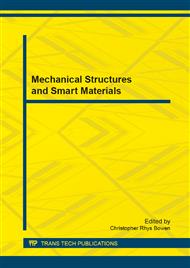[1]
E. J. Davies, and P. G. Simpson, Induction heating for industry, Electronics &Power 25 (1979) 508-515.
Google Scholar
[2]
R. M. Baker, and C. J. Madsen, High-frequency heating of conductors and nonconductors, Electrical Engineering 64 (1945) 50-57.
DOI: 10.1109/ee.1945.6440854
Google Scholar
[3]
H. F. Storm, Induction heating of long cylindrical charges, Electrical Engineering 65 (1946) 369-377.
DOI: 10.1109/ee.1946.6441730
Google Scholar
[4]
N. Aymard, and M. Féliachi, and B. Paya, An improved modified surface impedance for transverse electric problems, IEEE transactions on Magnetics 33 (1997) 1267-1270.
DOI: 10.1109/20.582485
Google Scholar
[5]
P. D. Agarwal, Eddy-current losses in solid and laminated iron, Transactions of the American institute of electrical engineers, Part I: Communication and Electronics 78 (1959) 169-181.
DOI: 10.1109/tce.1959.6372977
Google Scholar
[6]
A. L. Bowden, E. J. Davies, Analytic separation of the factors contributing to the eddy-current loss in magnetically nonlinear steel, IEE Proceedings B 130 (1983) 364-372.
DOI: 10.1049/ip-b.1983.0055
Google Scholar
[7]
C. W. Trowbridge, and J. K. Sykulski, Some key developments in computational electromagnetics and their attribution, IEEE transactions on magnetics 42 (2006) 503–508.
DOI: 10.1109/tmag.2006.872491
Google Scholar
[8]
R. cardoso mesquita, and Joáo Pedro Assumpcáo Bastos, 3D finite element solution of induction heating problems with efficient time-stepping, IEEE transactions on magnetics, 27 (1991) 4065–4068.
DOI: 10.1109/20.104994
Google Scholar
[9]
L. Gong, R. Hagel, and R. Unbehauen, A new approach to the nonlinear eddy current field coupled to the nonlinear heat transfer, IEEE Transactions on Industry Applications 31 (1995) 733-736.
DOI: 10.1109/28.395281
Google Scholar
[10]
F. Bioul, and F. Dupret, Application of asymptotic expansions to model two dimensional induction heating systems. Part I: calculation of electromagnetic field distribution, IEEE transactions on magnetics, 41 (2005) 2496–2505.
DOI: 10.1109/tmag.2005.854325
Google Scholar
[11]
K. F. Wang, S. Chandrasekar, and H. T. Y. Yang, Finite-element simulation of induction heat treatment, Journal of Materials Engineering and Performance 1 (1992) 97–112.
DOI: 10.1007/bf02650041
Google Scholar
[12]
P. Urbanek, A. Skorek, and M. B. Zaremba, Magnetic flux and temperature analysis in induction heated steel cylinder, IEEE transactions on magnetics 30 (1994) 3328–3330.
DOI: 10.1109/20.312650
Google Scholar
[13]
G. D. Garbulsky, P. Marino, and A. Pignotti, Numerical model of induction heating of steel-tube ends, IEEE transactions on magnetics 33 (1997) 746-752.
DOI: 10.1109/20.560108
Google Scholar
[14]
C. Chaboudez, S. Clain, R. Glardon, D. Mari, J. Rappaz, M. Swierkosz, Numerical modeling in induction heating for axisymmetric geometries, IEEE transactions on magnetics, 33 (1997) 739-745.
DOI: 10.1109/20.560107
Google Scholar
[15]
J. Nerg, and J. Partanen, Numerical solution of 2D and 3D induction heating problems with nonlinear material properties taken into account, IEEE transactions on magnetics 36 (2000) 3119-3121.
DOI: 10.1109/20.908705
Google Scholar
[16]
U. Lüdtke, D. Schulze, Numerical simulation of continuous induction steel bar end heating with material properties depending on temperature and magnetic field, IEEE transactions on magnetics 34 (1998) 3110-3113.
DOI: 10.1109/20.717728
Google Scholar
[17]
M. Enokizono, H. Tanabe, Numerical analysis of high-frequency induction heating including temperature dependence of material characteristics, IEEE transactions on magnetics 31 (1995) 2438-2444.
DOI: 10.1109/20.390154
Google Scholar
[18]
M. Feliachi, and G. Develey, Magneto-thermal behavior finite element analysis for ferromagn-etic materials in induction heating devices, IEEE transactions on magnetics 27 (1991) 5235-5237.
DOI: 10.1109/20.278798
Google Scholar
[19]
A. Razek, J. L. Coulomb, M. Feliachi, and J.C. Sabonnadiere, Conception of an air-gap element for the dynamic analysis of the electromagnetic field in electric machines, IEEE Transaction on magnetics 18 (1982) 655-659.
DOI: 10.1109/tmag.1982.1061898
Google Scholar
[20]
D. Rodger, H. C. Lai and P. J. Leonard, Coupled elements for problems involving movement, IEEE Transaction on magnetics 26 (1990) 548-550.
DOI: 10.1109/20.106375
Google Scholar
[21]
I.A. Tsukerman, Overlapping finite elements for problems with movement , IEEE Transaction on magnetics 28 (1992) 2247–2249.
DOI: 10.1109/20.179458
Google Scholar
[22]
A. Demenko, Movement simulation in finite element analysis of electric machine dynamics, IEEE Transaction on magnetics 32 (1996) 1553-1556.
DOI: 10.1109/20.497547
Google Scholar
[23]
O. Bíró, and K. Preis, On the use of the magnetic vector potential in the finite element analysis of three-dimensional eddy currents, IEEE Transaction on magnetics 25 (1989) 3145- 3159.
DOI: 10.1109/20.34388
Google Scholar


